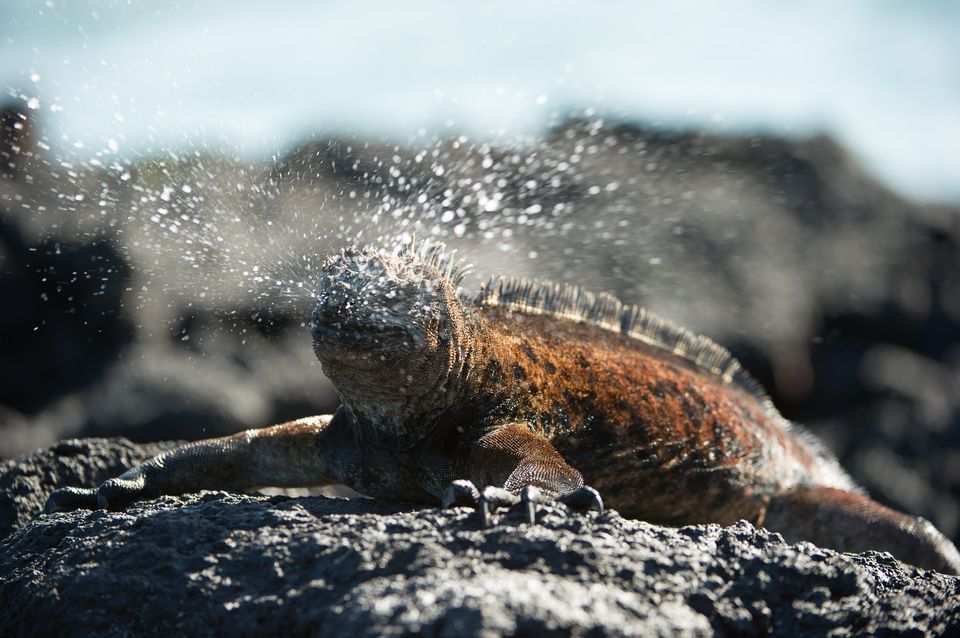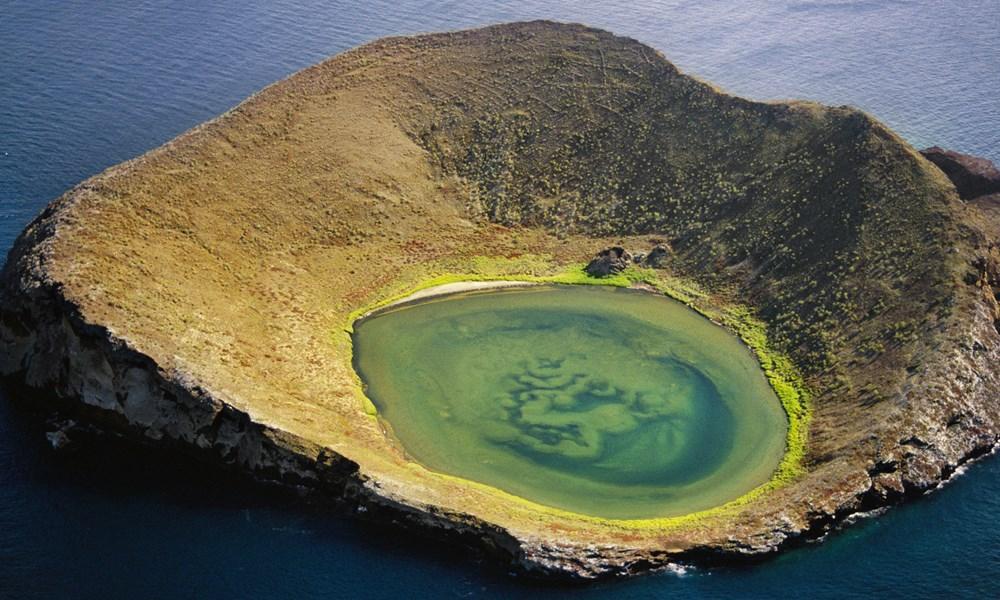Thursday,
February 7, 2019
We
spent the morning (7 am to 12 pm) at Punta Espinoza on the island of
Fernandina. The name in Spanish is Femandina, in honour of King
Fermando of Spain who sponsored the voyage of Christopher Columbus.


imagecredit:https://www.vacationstogo.com/cruise_port/Fernandina__Galapagos_Islands__Ecuador.cfm
Fernandina
is the most westernmost island and is 642 sq km, the 3rd
largest island. It is the youngest island. Darwin described it as
being “covered with immense deluges of black naked lava.” There
is not much plant life; it has a mostly rocky surface.
When we woke up it was raining, so we were trying to decide what to wear for our hike. Then it didn't matter because it cleared up and ended up being a hot walk again.
Yesterday there were only 20 people that signed up for the hard long walk so we were all one large group. They REALLY try to scare people about the difficulty of the walks or the snorkels. Today there were 40 people that chose the long walk. We were the last to arrive, so we were in the last zodiac to leave. The bonus was that there were only 5 people in our group!!!! Here is Frankie with Laurie:
When we woke up it was raining, so we were trying to decide what to wear for our hike. Then it didn't matter because it cleared up and ended up being a hot walk again.
Yesterday there were only 20 people that signed up for the hard long walk so we were all one large group. They REALLY try to scare people about the difficulty of the walks or the snorkels. Today there were 40 people that chose the long walk. We were the last to arrive, so we were in the last zodiac to leave. The bonus was that there were only 5 people in our group!!!! Here is Frankie with Laurie:
Punta
Espinoza (“Spiny Point”) is the only tourist landing site on the
island. There is a specially constructed landing dock, but it is
only accessible in high tide because of 20-36” of uplifting that
occurred in 1994.
It
is the most volcanically active of all the islands, even though it
only has one volcano. In 1968 the eruption was so violent that the
caldera collapsed 350 meters. The most recent major eruptions were
in 2005 and 2009. That eruption actually changed the coastline of
Fernandina. There are recent lava flows visible. This is a picture of the 2017 eruption:


imagecredit:https://www.lapintagalapagoscruise.com/la-cumbre-erupting-fernandina-island/
No
foreign species has ever invaded this island. It is considered the
most unspoiled of all the islands.
This
spot has the largest colony of marine iguanas in the Galapagos,
almost 400,000 of them. The most common phrase from Manuel our naturalist was, "Don't step on the iguanas".
Bitina our head naturalist said we are guaranteed to see about 3000 per kilometer. They are also the largest iguanas of the Galapagos. The ones we saw were about 3 feet long.
We saw a few iguanas that had wandered too far and had to scurry for the rocks when they saw the Galapagos Hawk:
Darwin called the iguanas “imps of darkness.” They are the only iguanas in the world that have learned to swim (diving up to 60 ft), tucking in their arms and legs, and using only their long, flat tail. They can stay under water for up to 10 minutes.
Bitina our head naturalist said we are guaranteed to see about 3000 per kilometer. They are also the largest iguanas of the Galapagos. The ones we saw were about 3 feet long.
We saw a few iguanas that had wandered too far and had to scurry for the rocks when they saw the Galapagos Hawk:
Darwin called the iguanas “imps of darkness.” They are the only iguanas in the world that have learned to swim (diving up to 60 ft), tucking in their arms and legs, and using only their long, flat tail. They can stay under water for up to 10 minutes.
The iguanas huddle together for warmth after
swimming. Since they are cold-blooded, they love to bask in the sun
on the black lava rocks. When they get too hot, they will face into
the sun to reduce their exposure. The iguanas can live up to 60
years.
The larger one in the next picture is a male iguana. There will be one male per colony. He is bigger and brighter than the females.
The larger one in the next picture is a male iguana. There will be one male per colony. He is bigger and brighter than the females.
The
iguanas eat only once a day. The dive into the cold water can reduce
their temperature by 10 C, so they come ashore to warm up before
digesting their food. The iguanas have special glands between their
eyes and their nostrils. These glands help them to eject excess salt
from the water.


imagecredit:https://www.reptilefact.com/marine-iguana.html
This is a group of females all headed up out of the lagoon, looking for a spot to lay their eggs:
We had to be careful when we walked through the area where the female iguanas lay their eggs. They dig burrows in the sand as long as 3 feet, and lay up to 4 eggs in the burrows. Sometimes there were several females fighting for one hole:
You can see from the picture above, the iguana tails leave very cool tracks in the sand.
The eggs will be in the sand for 3 to 4 months. They are 4” when they are born, and solid black to help them camouflage from predatory birds.
We had to be careful when we walked through the area where the female iguanas lay their eggs. They dig burrows in the sand as long as 3 feet, and lay up to 4 eggs in the burrows. Sometimes there were several females fighting for one hole:
You can see from the picture above, the iguana tails leave very cool tracks in the sand.
The eggs will be in the sand for 3 to 4 months. They are 4” when they are born, and solid black to help them camouflage from predatory birds.
Up
to 90% of marine iguanas in the Galapagos can be decimated during El
Nino years. The red and green algae that they eat disappears, and
the iguanas cannot digest the brown algae. They will literally
starve with full bellies. The iguanas have found a way to reduce
their body weight and bone mass during these times.


imagecredit:https://www.naturepl.com/stock-photo-marine-iguanas-amblyrhynchus-cristatus-basking-on-rock-next-to-image01535927.html
There
are also large numbers of Galapagos Sea Lions here because it is one
of the few western islands that has a sandy beach.
After our hike, we went back to the ship to change for our deep-water snorkel. This was not from the beach. The zodiac took us out to an area and we had to jump off and swim from there. The snorkeling here was just okay.
We did see a sea urchin that looked like this:

imagecredit:https://phys.org/news/2017-05-aggressive-reef-predator-impede-sea.html
As we were getting back on the ship, we were being observed by some Galapogos park rangers, to see if we were following regulations (how many per guide, etc):
Lunch on the deck. In
the afternoon, we went back to Isabela Island, this time to Punta
Vicente Roca, the snout of the seahorse (2 pm to 7 pm). Punta
Vicente Roca is named after yet another President of Ecuador. There
are no landings permitted here, only marine activities. This spot is
made of 2 coves on either side of the remains of a volcanic tuff
cone. Tuff cones are less common than cinder cones because they are
formed by magma-water eruptions. They have very steep sides and a
crater floor above ground level.

imagecredit:https://www.cruisemapper.com/ports/isabela-island-port-1548
Again, we were very brave and tried the deep-sea snorkel. We swam in a cove that is on the outside of the volcano:
The
water is cooler here due to the Cromwell Current from the west,
but this offers abundant food supply for marine life and it is common
to see “feeding frenzies.”
This was our best snorkeling yet, we didn't want it to end. Sometimes we got too close to the fish!
There were more sea turtles than we could count. It is tremendously fun to swim with sea turtles!
At one point Frankie was above water, and she did not see the turtle coming towards her. He came up for air and they were face to face, a foot apart!!!!
We got called back to the zodiac, and we reluctantly got in. Right after everyone was in, Anton spotted a Blacktip Shark!
We got back onto the ship, and an hour later we were back off for a zodiac ride. We went to the exact same cove that we had snorkeled in, but this time we were looking up instead of down into the water!
At one point Frankie was above water, and she did not see the turtle coming towards her. He came up for air and they were face to face, a foot apart!!!!
We got called back to the zodiac, and we reluctantly got in. Right after everyone was in, Anton spotted a Blacktip Shark!
We got back onto the ship, and an hour later we were back off for a zodiac ride. We went to the exact same cove that we had snorkeled in, but this time we were looking up instead of down into the water!
For example, we had not noticed the Blue-Footed Boobies. You
can tell the male and female Blue-Footed Boobies apart by their eyes.
The males have a lot of yellow in their eyes, while the females have
darker eyes.
And a colony of penguins:
There were a lot of Flightless Cormorants:
And we thought these were tiny baby sea lions, but they were actually Galapagos Fur Seals. Totally different from sea lions.
And a colony of penguins:
There were a lot of Flightless Cormorants:
And we thought these were tiny baby sea lions, but they were actually Galapagos Fur Seals. Totally different from sea lions.
Tonight the ship crossed north over the Equator. It will cross south back over it around 3 am.
























No comments:
Post a Comment